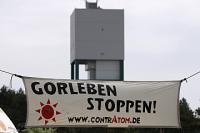More pictures at this Website, shot by an activist, are free to use.
Between 1,500 and 3,000 (depends on who's counting) German anti-nuclear activists demonstrated on 28 April against government deceit over waste storage plans. The conservative government says it's starting an "open ended" search for suitable sites other than Gorleben, a northern rural village between Hamburg and Hanover.
Activists allege it's just a furphy to keep Gorleben in the mix. Already 1.5 billion euros has been spent exploring the salt deposit there.
The activists want Gorleben dropped from the search because it has been proved geologically unsuitable beyond doubt.
The motto of the demo was "Der Fleck muss weg!", meaning that the black spot representing Gorleben on the supposedly empty map, has to go.
The federal government has been negotiating with the premiers of the 16 states about a dump location since the end of last year. The Greens and the government are said to have reached agreement, which has enraged Greens followers.
"Consensus between political parties is not consensus in society,” the activists argue.
The government has been saying it wants to compare “one or two other locations with Gorleben”.
A final repository law is to be ready by (northern) summer this year.
It was an impressive scene. Local farmers participated with 150 tractors. Demonstrators, including many artists of various kinds surrounded what activists allege is an illegal construction.
Speakers at a rally included Japanese nuclear opponents.
It was pointed out that Gorleben is no longer the only waste issue. A former iron mine near Braunschweig should also be scrapped from dumping plans. It’s the only approved new one and reported to be five years behind the construction schedule.
No conclusions are being drawn from failed dumps in Morsleben (a former mine in danger of collapsing on waste in it) and Asse (a former salt mine containing waste and now taking in thousands of litres of leaking brine daily).
Meanwhile mining and other works in the Gorleben pit continue.
“Anyone not learning lessons from the Asse wreck and holding on to Gorleben need not talk to us about final depositing in salt,” an activist said.
Past mistakes are being repeated. There is no consultation with competent and committed players like the environment t groups, anti-nuclear initiatives, trade unions and churches.
Facts are being created instead of debating the waste issue comprehensively.
After the rally activists of a group called “gorleben365″ blocked all entrances to the pit, intending to stay for several days.
Other German nuclear news in brief:
• Directly above the salt deposit German Greenpeace have bought a 1772m2 forest plot, including rights to the salt under it, to use as an information centre on nuclear waste disposal.
• From this year, German funding is to make nuclear projects possible in other countries. The money comes in government guarantees through a socalled Hermes insurance, which pays out if projects go belly up. Massive protests are being called. Activists are being urged to ring politicians to protest against insurane for German participation in the Angra 3 nuclear power station in Brazil.
• Indications are increasing that fewer girls than boys are being born in regions and times of increased radioactivity. Scientists have found similar abnormalities after atmospheric nuclear explosions, after the Chernobyl meltdown and around Gorleben and traced them back to the conception times. One study found an imbalance of 109 male to 100 female babies being born.
• With an election due in the most populous state, North-Rhine Westphalia, questions drawn up by an alliance of 30 anti-nuclear initiatives have been sent to the top candidates to answer.
Ukraine has launched construction of a new sarcophagus around the destroyed nuclear reactor at the Chernobyl plant. The aim is to secure the zone around the nuclear power station, which is still characterized by high radiation. Radioactive dust gets out, rain water gets in. Some experts have voiced doubts that the radiation problem will be solved with the new sarcophagus because the remaining radioactive material will not be removed.

